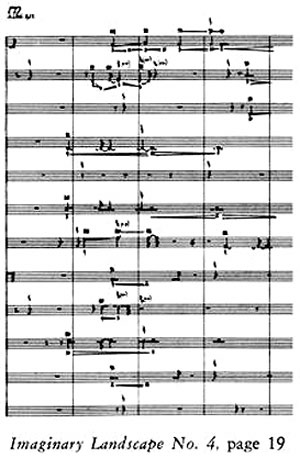Imaginary Landscape No. 4 is a musical composition created by John Cage in 1951. The video is from a Dec 5, 2008 performance by students of Profs. Joachim Pissarro and Geoffrey Burleson at Hunter College, New York. Burleson introduces the work, with the performance beginning at approximately 2:00 into the video.
“Two performers are stationed at each radio, one for dialling the radio-stations, the second performer controlling amplitude and timbre. Durations are written in conventional notation, using notes, placed on a five-line staff. The rhythmic structure of the work is 2-1-3 and is expressed in changing tempi. Cage uses proportional notation where ½ inch equals a quarter note. The notation is not entirely proportional though, since accelerandos and ritardandos are still present in the score. The score gives notations for tuning (controlled by player 1) as well as volume and tone color (controlled by the second player).”[1]
When one listens to the work, it is obvious that one cannot predict what will be heard, which is exactly what Cage was aiming at with this composition. Apart from that it was a way of abandoning his preferences and dislikes (Cage wasn’t very fond of radios). As he put it himself in For the Birds: “I had a goal, that of erasing all will and the very idea of success.”[1]
 “The method of composing is basically the same as used in Music of Changes. Cage used the I-Ching [an ancient Chinese book of wisdom also known as the Book of Changes] to create charts which refer to superimpositions, tempi, durations, sounds and dynamics. In the sound charts 32 out of 64 fields are silences. In the charts for dynamics, only sixteen produce changes, while the other maintain the previous situation. Similar charts were produced for the the other parameters.”[1]
“The method of composing is basically the same as used in Music of Changes. Cage used the I-Ching [an ancient Chinese book of wisdom also known as the Book of Changes] to create charts which refer to superimpositions, tempi, durations, sounds and dynamics. In the sound charts 32 out of 64 fields are silences. In the charts for dynamics, only sixteen produce changes, while the other maintain the previous situation. Similar charts were produced for the the other parameters.”[1]
In his essay, “To Describe the Process of Composition Used in Music of Changes and Imaginary Landscape No.4” (1952) published in his seminal book, Silence (1961, p 57-59), Cage argued that, “It is thus possible to make a musical composition the continuity of which is free of individual taste and memory (psychology) and also of the literature and ‘traditions’ of the art.” He continued, “The sounds enter the time-space centered within themselves, unimpeded by the service to any abstraction, their 360 degrees of cricumference free for an infinite play of interpenetration. Value judgments are not in the nature of this work as regards either composition, performance, or listening. The idea of relation being absent, anything may happen. A ‘mistake’ is beside the point,, for once anything happens it authentically is.”
[1] Galen Joseph-Hunter, “Transmission Works: Selections Towards Identifying a History” 2007. http://archive.free103point9.org/2007/07/08.transmissionworks.pdf
